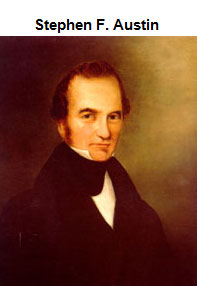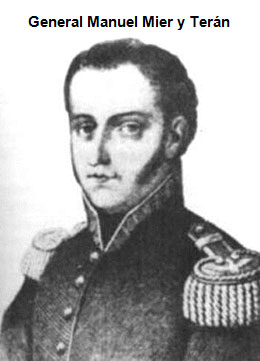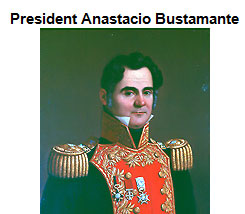
Source: Stephen F. Austin, Maksim, Wikimedia
In 1821, Mexico gained its independence from Spain after 300 years of Spanish colonization. To protect its northernmost borders (in Texas), Mexico quickly opened Texas up for colonization. The Mexican government offered land grants to empresarios to encourage people to move to Texas.

Source: Stephen F. Austin, Maksim, Wikimedia
Stephen F. Austin held the first land grant that brought the first 300 families to Texas.
In 1828, the Mexican government sent General Manuel de Mier y Terán on a mission to determine the United States-Mexico boundaries between the Red and Sabine rivers. Mier y Terán’s mission also included studying the number of Anglo-American settlers in Texas and determining the attitudes of those living in Texas. He traveled from Laredo to Nacogdoches, noting information about the lives of those influencing Texas at the time.

Source: Manuel Mier y Teran, Tatehuari, Wikimedia
Read the excerpts below from Mier y Terán’s report and answer the questions that follow in your notes.
“As one covers the distance from Béjar to this town, he will note that Mexican influence is proportionately diminished until on arriving in this place he will see that it is almost nothing. And indeed, whence could such influence come? Hardly from superior numbers in population, since the ratio of Mexicans to foreigners is one to ten; certainly not from the superior character of the Mexican population, for exactly the opposite is true, the Mexicans of this town comprising what in all countries is called the lowest class-the very poor and very ignorant.”
-Excerpt from Mier y Terán Report, Nacogdoches, June 30, 1828
Analyzing the excerpt: What happened to the Mexican influence in Nacogdoches? What did Mier y Terán cite as the reason for this change?

In summary, Mier y Terán’s report concluded the following:
Based on his findings, Mier y Terán made the following recommendations to the Mexican government:
Let’s think about this: Why did Mier y Terán recommend the increase of trade between Texas and Mexico?

At the end of his report, Mier y Terán warned Mexico to, “. . . take timely measures. Texas could throw the whole nation into revolution.”
It was clear from the report that tension was growing between the Texans and Mexican citizens. Mier y Terán’s warning prompted Mexican officials to protect Texas from increased settlement from the United States. His recommendations led to the Law of April 6, 1830. The Mexican government enacted several articles that were meant to stop U.S. immigration to Texas.
![]() Where does each article belong in the Cause/Effect chart? After reading the selected articles, determine how the articles of the Law of April 6, 1830 impacted Texans. Click on the question mark in the cause column for the corresponding article below.
Where does each article belong in the Cause/Effect chart? After reading the selected articles, determine how the articles of the Law of April 6, 1830 impacted Texans. Click on the question mark in the cause column for the corresponding article below.
While the Law of April 6, 1830 was meant to strengthen Mexican control over the colonists, the laws had other effects. The colonists felt that the Mexican government had punished them. Tensions between colonists and the Mexican government increased. Colonists felt that the Mexican government violated the colonists’ rights under the Constitution of 1824.
Colonists began to look at political options given to them by the Constitution of 1824. Colonists felt that the Mexican government was interfering in issues that should have been handled by the state.

Source: Anastacio Bustamante, PhilFree, Wikimedia
With President Bustamante in charge of the Mexican government the relationship between colonists and the Mexican government did not improve. On June 13, 1832, a group of Anglo-American settlers banned together and drew up a series of resolutions called the Turtle Bayou Resolutions.
![]() Click through the documents below to learn more about the Turtle Bayou Resolutions.
Click through the documents below to learn more about the Turtle Bayou Resolutions.
No actions were taken as a result of the Turtle Bayou Resolutions; however, settlers were now focused on addressing issues concerning the Mexican government. In October 1832, fifty-six Anglo-American settlers met at a convention in San Felipe, each representing districts in the Texas colonies.
The delegates elected Stephen F. Austin president of the convention. Under his leadership, several resolutions were adopted.
There were several other resolutions passed by the delegates, including the request that Coahuila y Tejas be divided so that Texas could become its own state. Stephen F. Austin traveled to San Antonio seeking support from Mexican officials. The Mexican government did not recognize the resolutions, claiming that the convention was unauthorized.
In April 1933, delegates called another convention while Stephen F. Austin was still away. At this convention, the delegates drafted the same resolutions, but they also created a constitution for a separate state of Texas.
Let's think about this: How do you think the Mexican government reacted to the drafting of the new constitution for Texas?

After the Convention of 1833, Stephen F. Austin went to Mexico City to deliver the resolutions. After three months of travel, Austin found Mexico City in a state of chaos. There was an outbreak of cholera in which there were thousands of deaths. Additionally, Santa Anna had just led a revolution against the standing government and won. Santa Anna was now the President of Mexico and the general of the Mexican army.
In November 1933, Austin met with Santa Anna. The Mexican dictator agreed to most of the Texans’ resolutions; he opposed, however, a separate statehood for Texas. Austin was later arrested and placed in prison by Mexican officials after a letter he had written to Texans was intercepted. The letter suggested that Texas establish a new state government that was separate from Coahuila. Austin was imprisoned for more than a year and did not return to Texas until 1835.
Each of these events led to the Texas Revolution. In the next section, you will read about the battles associated with the Texas Revolution.